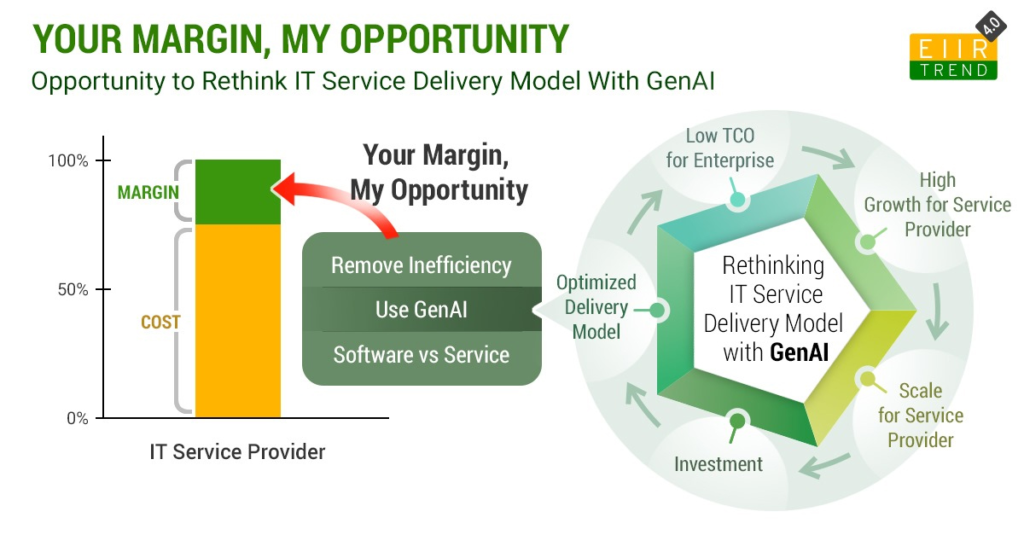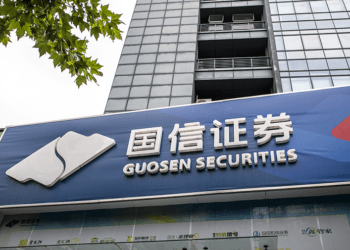Pareekh Jain, Founder & CEO of Pareekh Consulting & EIIR Trend
Jeff Bezos is famously quoted as saying, “Your margin is my opportunity,” highlighting the potential to challenge high-profit sectors by providing good services at lower margins but with significant volume and scalability.
Can this concept be applied to the IT service industry? In essence, can new entrants or existing players disrupt the current high-margin IT service delivery model by offering quality services at reduced margins and doing so on a large scale?
Let’s delve into the possibilities.

Evolution of the IT Service Industry and Its Last Major Disruption
The last significant disruption in the IT services industry was offshoring. Indian IT service providers burst onto the global scene with a better cost structure fueled by talent at scale in India, offering competitive pricing. Global IT service providers that weathered the offshoring disruption, such as Accenture, Capgemini, and IBM, had to establish a scaled delivery presence in India to remain competitive.
Despite numerous technology waves in IT services over the past few decades, including mainframe, client-server, web, enterprise applications, digital, and cloud, none caused prolonged disruption for incumbents. Instead, these technologies were integrated into the business models of existing IT service providers.
The question now is: Will things be different this time with GenAI? Will new players emerge, or will existing players adapt to new business models?
Trends Supporting the Next Disruption
Until a couple of years ago, discussing disruption possibilities might have seemed far-fetched. However, recent events and trends warrant at least a discussion on this topic.
Inefficiency in the technology process:
- There are inefficiencies in how software is designed, developed, tested, implemented, and maintained.
- The famous case of Elon Musk taking over Twitter (now X), firing 80% of the workforce, and X continuing to operate as usual highlights this issue.
While adopting such an approach may require the boldness of the world’s wealthiest person, technology is now on the horizon to enable this.
The most significant technology wave is GenAI
- GenAI PoCs across organizations indicate efficiency, product quality gains, and improvements throughout the software lifecycle.
- Many tech firms in the US have reduced headcounts recently without a significant impact on performance.
- The tech community is increasingly realizing that tomorrow’s software development may not require as many people as before, and both tech firms and enterprises can enhance efficiency with GenAI.
The other point is Software vs Services
- As off-the-shelf products become more available, the need for companies to develop their own applications and platforms diminishes. This discussion has been ongoing since the advent of enterprise applications, but with SaaS and cloud, more options are now available.
- Even many IT service providers have developed in-house products, and accelerators that help in client engagements. Most service providers use them as differentiators, reduce delivery time for clients, and enhance margins in fixed-cost projects.
- How about using software products more strategically versus services and doing fast customization and integration thus reducing the need for new software development?
What if? Envisioning a New Delivery Model.
Let’s fundamentally rethink how IT services are delivered by following three basic tenets:
- Removing Inefficiency
- Utilizing GenAI
- Balancing Software vs Services Mix
Effectively implementing the above will create a flywheel effect:
- An optimized delivery model
- Reduced TCO for enterprises
- High growth for service providers
- Scale for service providers
- Surplus for further investment, continuing the flywheel effect.
Do Clients Need It?
Who doesn’t want lower costs, especially in the B2B industry? Conversations with clients show they desire lower costs without compromising on delivery quality, preferring trusted brands.
There’s significant awareness of GenAI or ChatGPT on the consumer side. Clients are open to exploring these benefits on the enterprise side if credible options exist.
What Are the Challenges?
This approach or new delivery model is promising in theory but presents practical difficulties. There are challenges from both the enterprise and service provider perspectives.
On the enterprise side, scaling GenAI poses challenges in technology, data, security, explainability, and reliability. Even with intent, navigating these changes isn’t straightforward. Many banking applications, for example, still run on Cobol or Mainframe. Many tech clients follow the “don’t fix it if it’s not broken” policy.
For service providers who have thrived in the current model, pioneering a new approach can be daunting. It may cannibalize short-term revenue and impact margins, stock prices, and other metrics.
Disruptive vs. Sustaining Innovation.
It’s akin to disruptive versus sustaining innovation. History has shown that incumbents across indsutries typically favor sustaining innovation and are hesitant to disrupt existing models.
New or emerging service providers stand a better chance of adopting this disruptive approach to change the IT services delivery model.
There’s an opportunity for Private Equity to fund these disruptive IT service delivery models.
History has shown, as with the offshoring wave, that incumbents may not be pioneers or early adopters but can be fast followers.
Bottom Line:
Enterprises should demand a new delivery model. This will force service providers to rethink their assumptions. It takes two to tango. Unless enterprises demand it, the supply will not emerge. Hopefully, some service providers will be able to solve these challenges and kick-start this model with early enterprise adopters. Then, the majority of both enterprises and service providers will follow suit. Will GenAI lead to a disruptive or sustaining delivery business model? Time will tell.
(The writer is a veteran IT consultant and a voice of repute in the engineering services space globally. This blog has been published with permission from EIIR Trend, where it appeared first)





















